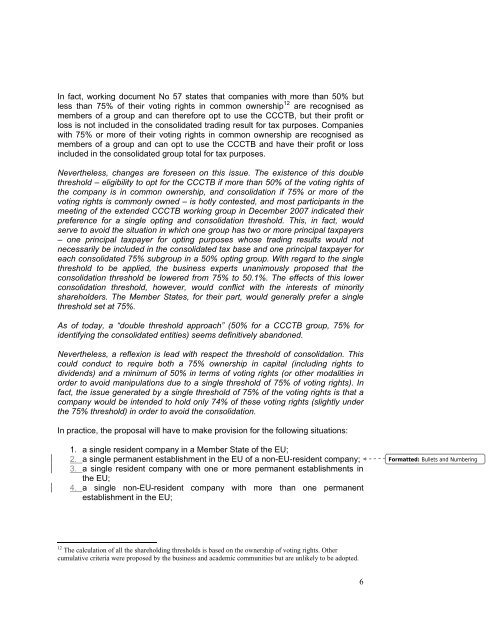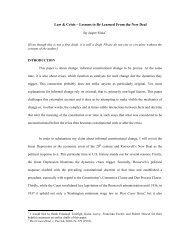An outline of the CCCTB (Common Consolidated Corporate Tax ...
An outline of the CCCTB (Common Consolidated Corporate Tax ...
An outline of the CCCTB (Common Consolidated Corporate Tax ...
You also want an ePaper? Increase the reach of your titles
YUMPU automatically turns print PDFs into web optimized ePapers that Google loves.
In fact, working document No 57 states that companies with more than 50% but<br />
less than 75% <strong>of</strong> <strong>the</strong>ir voting rights in common ownership 12 are recognised as<br />
members <strong>of</strong> a group and can <strong>the</strong>refore opt to use <strong>the</strong> <strong>CCCTB</strong>, but <strong>the</strong>ir pr<strong>of</strong>it or<br />
loss is not included in <strong>the</strong> consolidated trading result for tax purposes. Companies<br />
with 75% or more <strong>of</strong> <strong>the</strong>ir voting rights in common ownership are recognised as<br />
members <strong>of</strong> a group and can opt to use <strong>the</strong> <strong>CCCTB</strong> and have <strong>the</strong>ir pr<strong>of</strong>it or loss<br />
included in <strong>the</strong> consolidated group total for tax purposes.<br />
Never<strong>the</strong>less, changes are foreseen on this issue. The existence <strong>of</strong> this double<br />
threshold – eligibility to opt for <strong>the</strong> <strong>CCCTB</strong> if more than 50% <strong>of</strong> <strong>the</strong> voting rights <strong>of</strong><br />
<strong>the</strong> company is in common ownership, and consolidation if 75% or more <strong>of</strong> <strong>the</strong><br />
voting rights is commonly owned – is hotly contested, and most participants in <strong>the</strong><br />
meeting <strong>of</strong> <strong>the</strong> extended <strong>CCCTB</strong> working group in December 2007 indicated <strong>the</strong>ir<br />
preference for a single opting and consolidation threshold. This, in fact, would<br />
serve to avoid <strong>the</strong> situation in which one group has two or more principal taxpayers<br />
– one principal taxpayer for opting purposes whose trading results would not<br />
necessarily be included in <strong>the</strong> consolidated tax base and one principal taxpayer for<br />
each consolidated 75% subgroup in a 50% opting group. With regard to <strong>the</strong> single<br />
threshold to be applied, <strong>the</strong> business experts unanimously proposed that <strong>the</strong><br />
consolidation threshold be lowered from 75% to 50.1%. The effects <strong>of</strong> this lower<br />
consolidation threshold, however, would conflict with <strong>the</strong> interests <strong>of</strong> minority<br />
shareholders. The Member States, for <strong>the</strong>ir part, would generally prefer a single<br />
threshold set at 75%.<br />
As <strong>of</strong> today, a “double threshold approach” (50% for a <strong>CCCTB</strong> group, 75% for<br />
identifying <strong>the</strong> consolidated entities) seems definitively abandoned.<br />
Never<strong>the</strong>less, a reflexion is lead with respect <strong>the</strong> threshold <strong>of</strong> consolidation. This<br />
could conduct to require both a 75% ownership in capital (including rights to<br />
dividends) and a minimum <strong>of</strong> 50% in terms <strong>of</strong> voting rights (or o<strong>the</strong>r modalities in<br />
order to avoid manipulations due to a single threshold <strong>of</strong> 75% <strong>of</strong> voting rights). In<br />
fact, <strong>the</strong> issue generated by a single threshold <strong>of</strong> 75% <strong>of</strong> <strong>the</strong> voting rights is that a<br />
company would be intended to hold only 74% <strong>of</strong> <strong>the</strong>se voting rights (slightly under<br />
<strong>the</strong> 75% threshold) in order to avoid <strong>the</strong> consolidation.<br />
In practice, <strong>the</strong> proposal will have to make provision for <strong>the</strong> following situations:<br />
1. a single resident company in a Member State <strong>of</strong> <strong>the</strong> EU;<br />
2. a single permanent establishment in <strong>the</strong> EU <strong>of</strong> a non-EU-resident company;<br />
3. a single resident company with one or more permanent establishments in<br />
<strong>the</strong> EU;<br />
4. a single non-EU-resident company with more than one permanent<br />
establishment in <strong>the</strong> EU;<br />
12 The calculation <strong>of</strong> all <strong>the</strong> shareholding thresholds is based on <strong>the</strong> ownership <strong>of</strong> voting rights. O<strong>the</strong>r<br />
cumulative criteria were proposed by <strong>the</strong> business and academic communities but are unlikely to be adopted.<br />
6<br />
Formatted: Bullets and Numbering
















